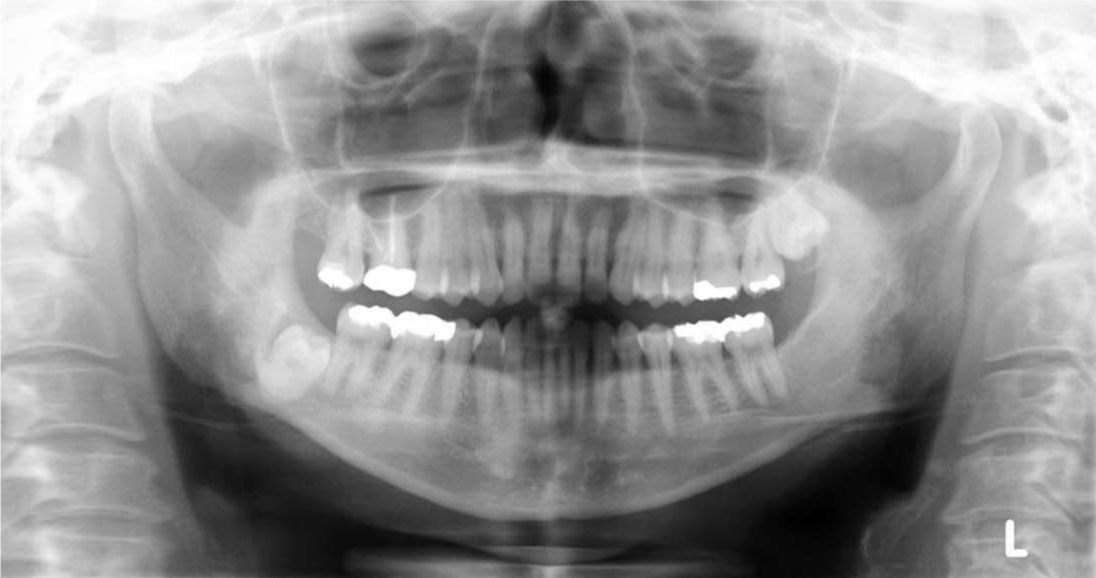Clinical Image
A Deeply-Impacted Mandibular Third Molar with its Root Protruding from the Lingual Plate
Nobumi Ogi1*, Yoshihiro Kimura2, Eri Izuhara2, and Mami Ito2
1Department of Oral and Maxillofacial Surgery, Aichi Gakuin University, Japan
2Department of Oral and Maxillofacial Surgery, Handa City Hospital, Japan
*Corresponding author: Nobumi Ogi, Department of Oral and Maxillofacial
Surgery, Aichi Gakuin University, 2-11 Suemori Dori, Chikusa Ku, Nagoya, 464-8651, Japan, Tel: 81-52-759-2111 ; Fax: 81-52-759-2158; Email:
href="ogi@dpc.agu.ac.jp
Submitted: 25 February 2019; Accepted: 17 April 2019; Published: 19 April 2019
Cite this article: Ogi N, Kimura Y, Izuhara E, Ito v (2019) A Deeply-Impacted Mandibular
Third Molar with its Root Protruding from the Lingual Plate. JSMC Dent 3: 2.
An impacted mandibular third molar with its root protruding
from the lingual plate is a rare occurrence. Excessive tooth
extraction force can displace a deeply-impacted third molar
into the adjacent fascial spaces. Computed tomography (CT) can
provide excellent visualization of the complex anatomy around
the tooth and aid in treatment planning for tooth removal.
A 45-year old female patient was referred to the department of
oral and maxillofacial surgery for removal of the right mandibular
third molar. Orthopantomography (OPG) showed that the third
molar was vertically deeply-impacted in the mandible (Figure 1).
CT disclosed that the root of the tooth was protruding from the
lingual plate (Figure 2).
Under general anesthesia, the lingual bone overlying the tooth
was removed and the tooth was cautiously extracted preventing
displacement of the third molar into the adjacent fascial spaces.
The post-operative course was uneventful.
The mandibular third molars are often misaligned/impacted
and indicated for extraction. Surgical removal of the third
molars is common in the field of oral and maxillofacial surgery.
In anatomy, a lingual undercut is frequently recognized in the
posterior mandibular region [1]. Cross-sectional CT images
can locate and evaluate the degree of a lingual concavity in the
mandible [1]. Hence, deeply-impacted mandibular third molars
can protrude their roots into the lingual undercut. During
extraction, the third molars might be displaced into the adjacent
spaces through fenestration or due to a thin lingual plate [2].
Displacement of the teeth or fragments into the anatomical spaces
is unlikely, but may result in serious iatrogenic complications
[2]. Displaced teeth or roots should be retrieved immediately to avoid devastating complications, such as, deep neck infections,
mediastinal infections, and airway obstruction [3].
Imaging diagnostics are essential to predict the anatomical
relationship among the teeth and surrounding structures. OPG
is useful as the first-line diagnostics and widely used to confirm
the position of the third molars and to observe the relationship
of the teeth to the inferior alveolar canal [4]. OPG reveals twodimensional
vertical and mesio-distal relation around the
teeth, but does not provide cross-sectional images. However,
CT with multiplanar reformatted views presents the accurate
relationship between the structures, discloses the presence of a
lingual undercut, and enhances intra-surgical safety [1].
It is recommended that oral surgeons be alert to removing
such deeply-impacted mandibular third molars. Incomplete
pre-operative assessment is one of the risk factors for the
displacement of the third molars and subsequent complications.
CT is highly instrumental in depicting the accurate position of the
malposed third molars and yielding detailed information with
cross-sectional images of mandibular bone morphology.
 Figure 1:The deeply-impacted right mandibular third molar. View Figure
Figure 1:The deeply-impacted right mandibular third molar. View Figure
 Figure 2:Axial CT image (A) and coronal CT image (B) showing the right mandibular third molar with its root protruding from the lingual plate. View Figure
Figure 2:Axial CT image (A) and coronal CT image (B) showing the right mandibular third molar with its root protruding from the lingual plate. View Figure






























